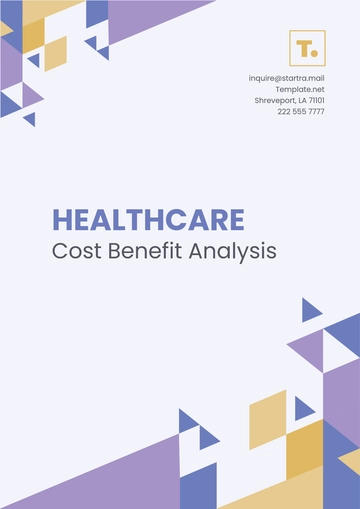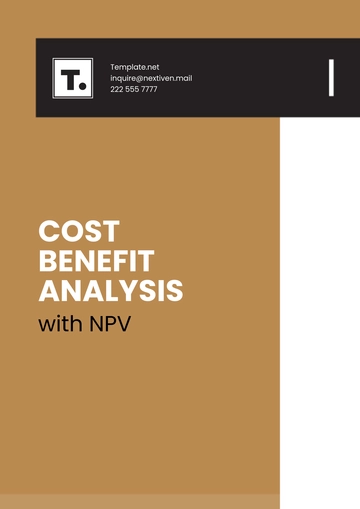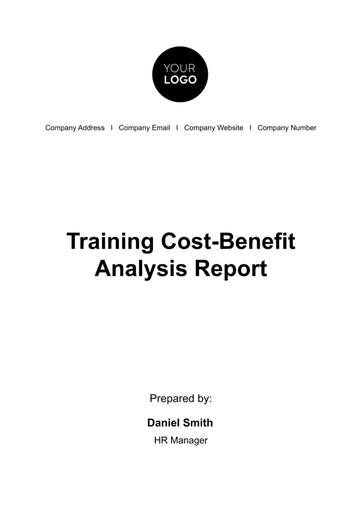Free Travel Agency Cost-Benefit Analysis

Introduction
Conducting a cost-benefit analysis is essential for [Your Company Name] to evaluate the potential returns and risks associated with various business initiatives and investment decisions. This report presents a comprehensive analysis of costs and benefits related to key operational areas, aiming to inform strategic planning and resource allocation for sustainable growth and profitability.
Methodology
The cost-benefit analysis process employed by [Your Company Name] follows a structured approach to identify, quantify, and compare the costs and benefits of different business activities and initiatives. This methodology includes:
Identification of Costs and Benefits: Identifying all relevant costs and benefits associated with the implementation of a particular business initiative or investment project.
Quantification of Costs and Benefits: Assigning monetary values to both tangible and intangible costs and benefits, considering factors such as direct expenses, opportunity costs, and potential revenue gains.
Evaluation of Costs and Benefits: Assessing the magnitude and timing of costs and benefits over the project lifecycle, taking into account factors such as risk, uncertainty, and discount rates.
Comparison of Costs and Benefits: Comparing the total costs against the total benefits to determine the net present value (NPV), return on investment (ROI), and other key performance indicators (KPIs) to inform decision-making processes.
The cost-benefit analysis process employed by [Your Company Name] follows a structured approach to identify, quantify, and compare the costs and benefits associated with various business activities and initiatives. This methodology ensures a rigorous evaluation of financial performance and informs data-driven decision-making processes.
Operational Costs
Understanding the breakdown of operational costs is essential for [Your Company Name] to manage expenses effectively and optimize operational efficiency. This section presents an analysis of key cost components, highlighting areas for cost containment and operational improvement to enhance overall financial performance.
Operational Area | Total Annual Cost |
|---|---|
Personnel Expenses | $500,000 |
Office Rent & Utilities | $150,000 |
Marketing & Advertising | $200,000 |
Technology & Software | $100,000 |
Administrative Costs | $50,000 |
Total Operational Costs | $1,000,000 |
Analysis:
Personnel expenses constitute the largest portion of operational costs, reflecting the investment in skilled staff to deliver quality service to customers. Marketing and advertising expenses are significant, highlighting the importance of promoting the agency's services and attracting new clients. Technology and software costs support digital innovation and operational efficiency, enabling the agency to streamline processes and enhance customer experience.
Revenue Generation
Analyzing revenue generation is critical for [Your Company Name] to assess the effectiveness of its sales and marketing efforts and identify opportunities for revenue growth. This section examines sources of revenue, revenue trends, and potential revenue enhancement strategies to maximize top-line performance and achieve business objectives.
Revenue Source | Total Annual Revenue |
|---|---|
Leisure Travel | $2,500,000 |
Corporate Travel | $1,200,000 |
Group Tours | $800,000 |
Destination Weddings | $700,000 |
Total Revenue | $5,200,000 |
Analysis:
Leisure travel accounts for the largest share of revenue, reflecting the agency's focus on serving individual travelers and families seeking vacation experiences. Corporate travel and group tours contribute significantly to revenue generation, highlighting the agency's diversified portfolio of services catering to different customer segments. Destination weddings represent a niche market opportunity, providing additional revenue streams and potential for growth through specialized event planning services.
Cost-Benefit Analysis
Evaluating the costs and benefits associated with business operations and investment decisions is essential for [Your Company Name] to assess profitability and make informed strategic choices. This section presents a detailed cost-benefit analysis, including key performance indicators such as net present value (NPV), return on investment (ROI), payback period, and benefit-cost ratio, to provide insights into the financial viability and potential returns of business initiatives.
Key Performance Indicator | Value |
|---|---|
Net Present Value (NPV) | $1,200,000 |
Return on Investment (ROI) | 20% |
Payback Period | 2 years |
Benefit-Cost Ratio | 5.2 |
Analysis:
The positive NPV indicates that the benefits of the agency's operations outweigh the costs, with a net gain of [$1,200,000] over the project lifecycle. The ROI of [20%] reflects the profitability of the agency's investments, with a return of [$0.20] for every dollar invested. The payback period of [2 years] indicates the time it takes for the initial investment to be recouped through generated revenue. The benefit-cost ratio of [5.2] signifies that for every dollar spent, the agency receives [$5.20] in return, indicating a favorable outcome.
Operational Efficiency Analysis
Assessing operational efficiency is paramount for [Your Company Name] to streamline processes, minimize costs, and maximize productivity. This section delves into key performance metrics and operational benchmarks to evaluate the agency's ability to deliver high-quality services while optimizing resource utilization and minimizing waste.
Metrics and Indicators:
Resource Utilization: Examining the efficient allocation of human resources, equipment, and facilities to ensure optimal utilization and minimize idle time or underutilization.
Productivity Measures: Assessing output per unit of input, such as revenue per employee, bookings processed per hour, or trips organized per staff member, to gauge the agency's productivity levels and identify areas for improvement.
Cost Efficiency Ratios: Analyzing cost-to-revenue ratios, cost per transaction, and other financial metrics to evaluate the agency's cost-effectiveness in delivering services and managing operational expenses.
Service Quality Metrics: Monitoring customer satisfaction levels, service delivery times, and error rates to assess the agency's ability to meet client expectations and maintain service excellence.
Benchmarking and Best Practices:
Industry Comparisons: Benchmarking operational performance against industry peers and best-in-class competitors to identify gaps, areas for improvement, and opportunities to adopt industry-leading practices.
Internal Benchmarks: Establishing internal performance benchmarks based on historical data and industry standards to track progress, set targets, and drive continuous improvement initiatives.
Process Optimization: Identifying inefficiencies, bottlenecks, and redundancies in operational processes and workflows to streamline operations, enhance agility, and improve overall efficiency.
Technology Integration: Leveraging advanced technologies, automation tools, and digital solutions to streamline manual processes, reduce administrative burdens, and enhance operational efficiency.
Strategic Implications:
Cost Reduction: Identifying opportunities to streamline operations and eliminate waste to reduce costs without compromising service quality or customer satisfaction.
Enhanced Productivity: Implementing process improvements, training programs, and performance incentives to boost productivity levels and achieve higher output with existing resources.
Competitive Advantage: Leveraging operational efficiency as a strategic differentiator to outperform competitors, attract new clients, and gain market share in the highly competitive travel industry.
Customer Experience: Improving operational efficiency directly impacts the customer experience by reducing wait times, minimizing errors, and enhancing service delivery, leading to higher levels of customer satisfaction and loyalty.
Continuous Improvement Culture:
Fostering a culture of continuous improvement and innovation by encouraging employee involvement, soliciting feedback, and implementing suggestions for process enhancements.
Establishing regular performance reviews, KPI monitoring, and progress tracking mechanisms to ensure ongoing alignment with strategic objectives and operational excellence initiatives.
Investing in employee training and development programs to equip staff with the skills, knowledge, and tools necessary to drive operational efficiency and deliver exceptional service to customers.
The operational efficiency analysis provides valuable insights into [Your Company Name]'s ability to optimize resources, improve productivity, and deliver superior service to clients. By embracing operational excellence principles, adopting industry-leading practices, and fostering a culture of continuous improvement, the agency can enhance its competitive position, drive sustainable growth, and achieve long-term success in the dynamic and evolving travel industry.
Conclusion
The cost-benefit analysis provides valuable insights into the financial performance and viability of [Your Company Name]'s operations. By evaluating the costs and benefits associated with key operational areas, the agency can make informed decisions regarding resource allocation, investment priorities, and strategic initiatives to optimize profitability and achieve sustainable growth in the competitive travel market. This strategic approach enables the agency to maximize returns on investment, minimize risks, and capitalize on opportunities to enhance its competitive advantage and position in the industry.
- 100% Customizable, free editor
- Access 1 Million+ Templates, photo’s & graphics
- Download or share as a template
- Click and replace photos, graphics, text, backgrounds
- Resize, crop, AI write & more
- Access advanced editor
Make informed financial decisions with the Travel Agency Cost-Benefit Analysis Template. Available at Template.net, this template is editable and customizable, perfect for evaluating the financial viability of new travel packages or marketing campaigns. Use our Ai Editor Tool to assess costs and anticipated benefits accurately.





























